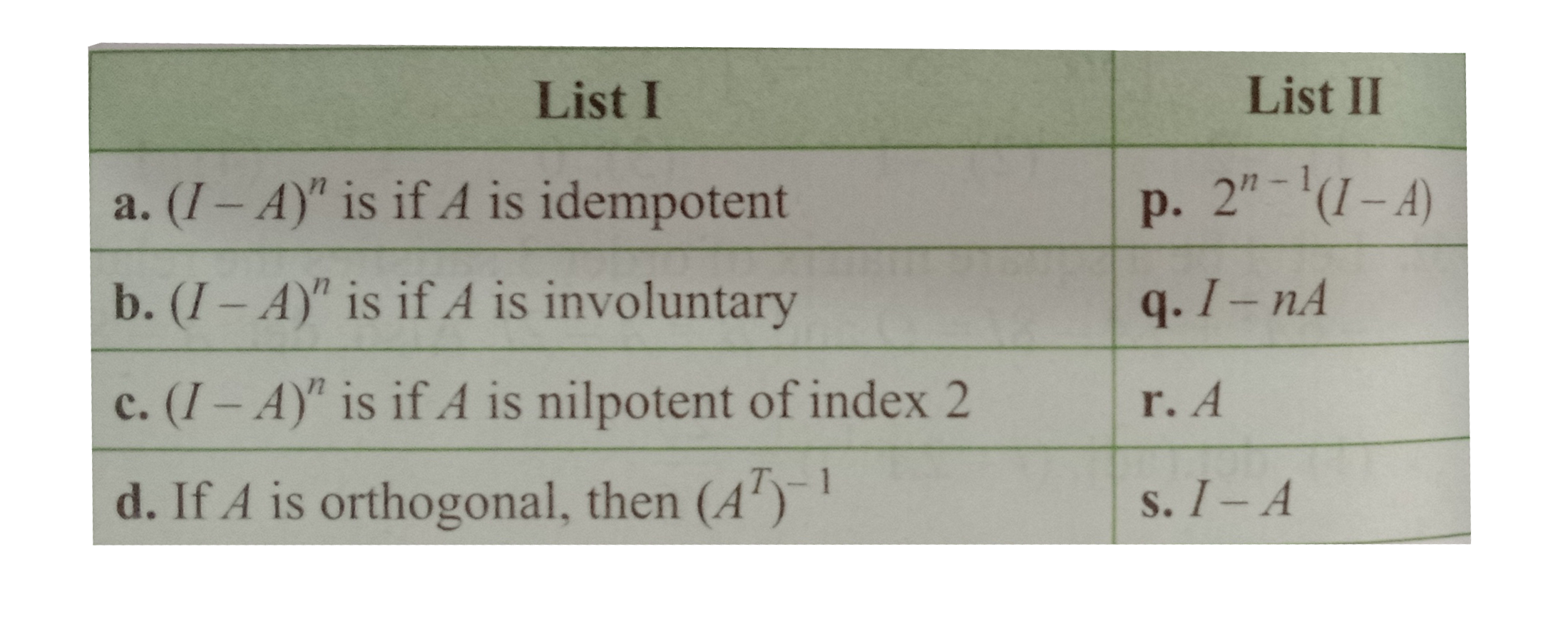If A and B are two non singular matrices and both are symmetric and commute each other, thenSolution in Tamil
A−1B
AB−1
A−1B−1
none of these
Given that A and B commute, we have
AB=BA (∵ A and B are symmetric) (1)
Also,
AT=A,BT=B (2)
(A−1B)T=BT(A−1)T=BA−1
( ∵ if A is symmetric, A−1 is also symmetric)
Also from Eq. (1),
ABA−1=B (3)
or A−1ABA−1=A−1B
or IBA−1=A−1B
or BA−1=A−1B
Hence, from Eq. (2),
(A−1B)T=A−1B
Thus, A−1B is symmetric. Similarly, AB−1 is also symmetric. Also,
BA=AB
or (BA)−1=(AB)−1
or A−1B−1=B−1A−1
or (A−1B−1)T=(B−1A−1)T
=(A−1)T(B−1)T
=A−1B−1
Hence, A−1B−1 is symetric.
Topper's Solved these Questions
- BOOK - CENGAGECHAPTER - MATRICESEXERCISE - Exercise (Comprehension)18videos
MATRICES
- BOOK - CENGAGECHAPTER - MATRICESEXERCISE - Exercise (Matrix)5videos
MATRICES
- BOOK - CENGAGECHAPTER - MATRICESEXERCISE - Exercise (Single)65videos
MATRICES
- BOOK - CENGAGECHAPTER - MATHMETICAL REASONINGEXERCISE - JEE Previous Year10videos
MATHMETICAL REASONING
- BOOK - CENGAGECHAPTER - METHODS OF DIFFERENTIATIONEXERCISE - Multiple Correct Answer Type7videos
METHODS OF DIFFERENTIATION
Similar Questions
Let a be a matrix of order 2×2 such that A2=O.
A2−(a+d)A+(ad−bc)I is equal to02:27View SolutionMatch the following lists :
 04:13View Solution
04:13View SolutionIf A is symmetric as well as skew-symmetric matrix, then A is
03:48View SolutionStatement-1: ~(p↔~q) is equivalent to (p↔q).
Statement-2: ~(p↔~q) is a tautology.02:48View SolutionEvaluate: ∫[√1+x2+x]n√1+x2dx
01:49View SolutionIf A and Bare two non-zero square matrices of the same order, such that AB=0, then (a) at least one of A and B is singular (b) both A and B are singular (c) both A and B are non-singular (a) none of these
01:29View SolutionIf a and B are non-singular symmetric matrices such that AB=BA, then prove that A−1B−1 is symmetric matrix.
03:26View SolutionIf A and B are two non singular matrices and both are symmetric and commute each other, then
03:24View SolutionIf A and B are two non-singular matrices which commute, then (A(A+B)−1B)−1(AB)=
03:12View SolutionIf A and B are two non-singular matrices which commute, then (A(A+B)−1B)−1(AB)=
02:31View SolutionIf A and B are non-singular matrices, then
02:54View SolutionIf A and B are non-singular symmetric matrices such that AB=BA, then prove that A−1B−1 is symmetric matrix.
04:02View SolutionIf A and B are two non singular matrices and both are symmetric and commute each other, then
03:47View SolutionIf A and B are two non singular matrices and both are symmetric and commute each other, then
01:56View SolutionIf A and B are two non-singular matrices which commute, then (A(A+B)−1B)−1(AB)=
04:21View Solution

